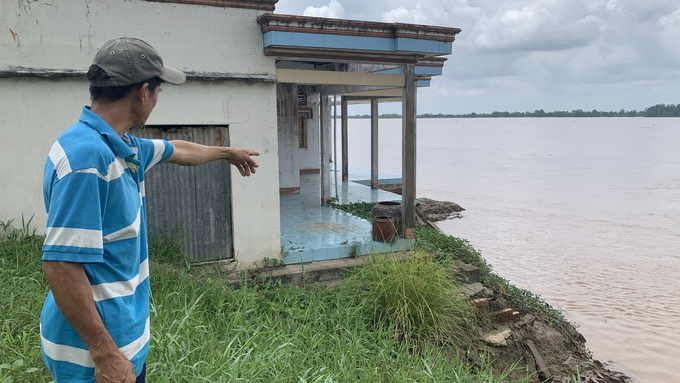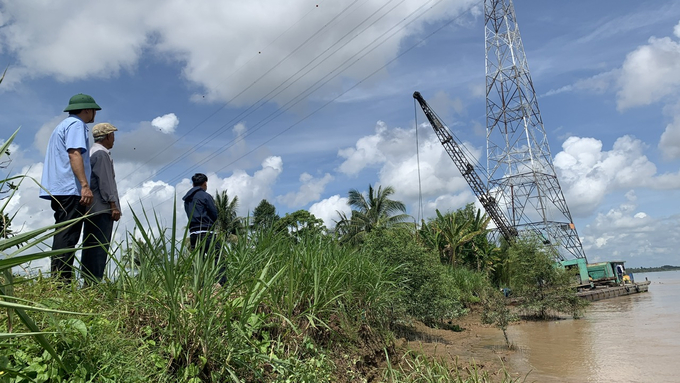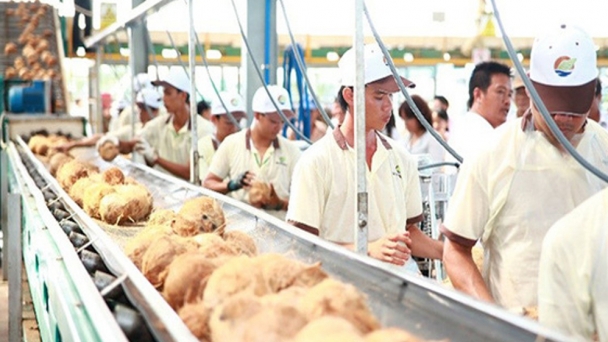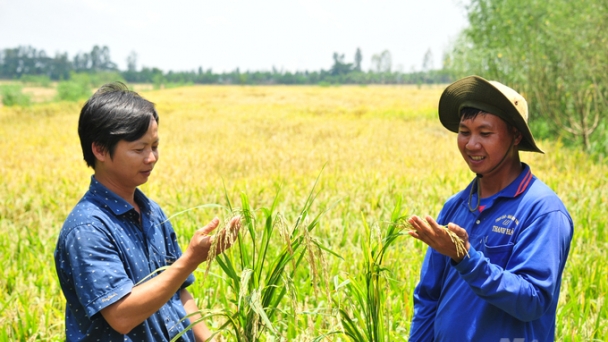December 21, 2024 | 22:12 GMT +7
December 21, 2024 | 22:12 GMT +7
Hotline: 0913.378.918
December 21, 2024 | 22:12 GMT +7
Hotline: 0913.378.918

Residents living on the islets in the Mekong Delta are worried that future generations will have no land for cultivation due to the increasingly severe erosion. Photo: Ho Thao.
Over 1,000 erosion points
Once known as the "walking land" due to the annual deposition of sediment from the Mekong River, the Mekong Delta is now facing severe land loss. Scientists predict that the number of erosion incidents in this region will increase over the next few decades with alarming consequences.
The Climate Change Research Institute (Can Tho University) reports that riverbank and coastal erosion, along with land subsidence in the Mekong Delta, have reached critical levels. The region loses 600-800 hectares of land annually, with over 1,000 erosion points forcing thousands of households to relocate from dangerous areas.
Projections indicate that by 2040, only 3-5% of the sediment will reach the Mekong Delta, as most is trapped by upstream hydropower dams. The lack of sediment exacerbates riverbank and coastal erosion in the lower Mekong. Additionally, excessive sand mining in the rivers destabilizes riverbeds, causing erosion and subsidence.
Assoc. Prof. Dr. Le Anh Tuan from the Climate Change Research Institute warned that erosion in the Mekong Delta could continue for decades due to reduced sediment from the Mekong River and excessive sand and groundwater extraction. The deepening of rivers and steepening of banks leads to landslides and erosion as the land attempts to compensate.
"The Tien and Hau rivers, the Delta's two main rivers, now have deeper beds, so sediment is drawn from tributaries to compensate. These tributaries, in turn, deplete their own branches, spreading erosion throughout the region, especially in weak soil areas like the islets," explained Assoc. Prof. Dr. Le Anh Tuan.
Thanh Long Islet in Vinh Long Province has become a "hotspot" for climate change impacts. Each year, the islet experiences about 10 erosion events, losing approximately 30 hectares of farmland. Residents report increasing erosion, severely affecting their lives, with many abandoning their homes and land. Only six households remain.
"Previously, erosion happened once or twice a year during flood season, but now the dikes are breaking year-round. Each time it happens, we pool money to hire excavators to reinforce the dikes, but they soon collapse again," lamented Nguyen Chi Lap, a resident of Thanh Long Islet.

Local authorities and residents of Thanh Long Islet are hiring equipment to reinforce the dikes in areas that frequently experience erosion. Photo: Ho Thao.
Similarly, in the coastal area of Duyen Hai town, Tra Vinh province, around 40 hectares of protective forest are eroded and washed away by waves each year, encroaching further inland. Despite efforts by local authorities to plant new trees, the reforestation efforts have not kept pace with the rate of erosion.
One significant example is an 8-kilometer stretch of coastline from Truong Long Hoa commune to Vam Lang Nuoc (Duyen Hai town), where erosion threatens the lives of thousands of coastal households.
Ton Thi Hau, a resident of Nha Mat hamlet, Truong Long Hoa commune, once enjoyed a stable livelihood by farming shrimp and fishing under the mangrove forest canopy. However, in recent years, the mangrove forest has been gradually washed away by the sea, leading to the encroachment of seawater into her shrimp ponds. Her family was forced to move inland to plant cassava and other crops. Yet, this work has not been easy, as sea winds have destroyed the windbreak dikes, causing her crops to fail.
"Sea sand and salt carried by the sea breeze cause the leaves of the plants to dry up and burn, reducing yields. I now harvest only about 500 kilograms of cassava per hectare, which is 50% less than before. Additionally, erosion is approaching the edge of my land, and we desperately need investment in a sea dike to ensure we can farm safely," she lamented.
The combination of non-structural solutions
Some researchers believe that over the years, the Mekong Delta provinces have invested significant resources into building embankments to protect riverbanks and coastlines from erosion. However, despite the high cost, constructing concrete embankments is not a long-term solution, as some sections have experienced subsidence and erosion just a few years after being built.
Assoc. Prof. Dr. Le Anh Tuan stated that constructing solid embankments is necessary in densely populated areas and those of strategic importance. However, in sparsely populated or high-risk areas, relocating residents should be prioritized. In the long term, a combination of structural and non-structural solutions should be implemented.

A house belonging to a resident, which has been eroded, precariously sits on the riverbank. Photo: Ho Thao.
"In the past four years, Hau Giang has built over 200km of ecological embankments along primary and secondary canals, yielding significant results. These embankments are made by local residents using bamboo or melaleuca stakes, ground-covering nets, and planting trees like melaleuca, mangrove apple, coconut, and hog plum. After 2-3 years, the embankments stabilize, not only preventing erosion but also providing economic benefits through fruit trees. The cost of ecological embankments is about 150,000 VND per square meter, one-tenth the cost of concrete embankments, and they can be easily implemented by households," he explained.
He also emphasized that local authorities should map high-risk erosion areas and strictly manage the river systems. The irrigation sector should research ways to stabilize riverbeds in key economic and residential areas. Additionally, he proposed reducing the area of third-season rice embankments in flood-prone regions, opening dikes to receive sediment and reducing strong currents that pose dangers downstream.
Regarding infrastructure, Assoc. Prof. Dr. Le Anh Tuan suggested building elevated highways in low-lying areas instead of using river sand for filling. Designing elevated highways with cement girders or alternative materials would not only save river sand resources but also reduce erosion risks by limiting sand extraction.
Assoc. Prof. Dr. Le Anh Tuan from the Climate Change Research Institute (Can Tho University) warned that land loss due to erosion in the Mekong Delta has nearly doubled compared to five years ago. Long-term solutions from various sectors are needed to minimize damage. "In housing construction, instead of using sand for elevation, it is better to design the lower level as a parking area. This not only conserves sand but also reduces pressure on the riverbanks," he further suggested.
Translated by Mai Quang Huy

(VAN) On the evening of December 18th in Hanoi, the Ministry of Science and Technology held a ceremony to present the National Quality Awards for the years 2021, 2022 and 2023 to 133 businesses.

(VAN) On December 18, MARD and the People's Committee of Tien Giang Province hosted a forum in My Tho City to discuss the promotion of FDI and the increase in the export of coconut products.

(VAN) The C.P. Vietnam Animal Feed Industry won multiple awards at the 'National Quality Awards Ceremony, Asia-Pacific Quality Awards 2021-2023'.

(VAN) A new non-photosynthetic plant founded in Xuan Lien Nature Reserve, adding further evidence that it is one of the most biologically diverse and ecologically significant protected areas in Vietnam.

(VAN) Ecological rice farming not only reduces the impact of agricultural chemicals but also leverages the benefits of the flood season to restore the field ecosystem.
/2024/12/19/0314-0-nongnghiep-180309.jpg)
(VAN) With the motto of bringing vegetarian food to the world, Vuong Ngoc Vegan Company has turned cashew fruits, considered a waste product in agriculture, into premium vegetarian fish sauce.

(VAN) New technology enables hatcheries to quickly peer into millions of fertilized eggs and spot male embryos, then grind them up before they mature into chicks.